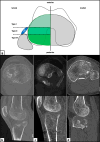Location of lateral tibial plateau fractures relative to the posterolateral complex predicts the need for extension of lateral approaches: A retrospective observational study
- PMID: 40691664
- PMCID: PMC12279580
- DOI: 10.1007/s00068-025-02933-4
Location of lateral tibial plateau fractures relative to the posterolateral complex predicts the need for extension of lateral approaches: A retrospective observational study
Abstract
Purpose: Extended lateral approaches have been proposed to improve visualization and therefore reduction quality of the articular surface in lateral tibial plateau fractures. However, recommendations regarding the exact morphology of lateral tibial fractures requiring extended approaches are lacking.
Methods: A retrospective observational cohort study was conducted using data from patients who underwent surgical treatment of a tibial plateau fracture involving the lateral tibial plateau (AO/OTA 41-B3 and 41-C3) at a level 1 trauma center between January 2020 and May 2024. Demographics, patient positioning, and surgical approaches were recorded. Comprehensive examinations on preoperative computed tomography (CT) scan were performed evaluating the morphology of lateral tibial plateau fractures relative to the posterolateral ligamentous structures.
Results: 143 patients (53.8% female, 46.2% male) with a mean age of 51.3 ± 14.3 years were included. Three distinct types of lateral tibial plateau fractures were identified. The most frequent fracture types observed were anterior to the posterolateral ligamentous structures (38.5%) and at level of the posterolateral complex (36.4%), followed by a fracture location posterior to the posterolateral ligamentous structures (25.1%). Extended lateral approaches using lateral femoral epicondyle osteotomy were performed in 17.5% of cases, with fractures posterior to the posterolateral ligamentous structures more likely to have an extended approach (80.0%, p < 0.001).
Conclusions: Lateral tibial plateau fractures show three distinct fracture types, with the fracture location relative to the posterolateral ligamentous structures predicting extension of lateral approaches. For fractures extending posterior to the posterolateral complex, preoperative planning should include prone or lateral patient positioning and selection of an extended lateral approach.
Level of evidence: III.
Keywords: Extended lateral approaches; Fracture type-specific approach selection; Lateral epicondyle osteotomy; Tibial plateau fracture.
© 2025. The Author(s).
Conflict of interest statement
Declarations. Ethics approval: The study was reviewed and approved by the Institutional Ethics Committee of the University of Muenster (File number 2024-421-f-S). Social Media Summary: Location of lateral tibial plateau fractures relative to the posterolateral complex was found to be an indicator for extension of lateral approaches @UK_Muenster Competing interests: The authors declare no competing interests.
Figures




Similar articles
-
[Osteotomy of non-core weight-bearing area of the lateral tibial plateau, reduction, and internal fixation in treatment of tibial plateau fractures involving posterolateral column collapse].Zhongguo Xiu Fu Chong Jian Wai Ke Za Zhi. 2023 Apr 15;37(4):410-416. doi: 10.7507/1002-1892.202301019. Zhongguo Xiu Fu Chong Jian Wai Ke Za Zhi. 2023. PMID: 37070306 Free PMC article. Chinese.
-
What Is the Patient-reported Outcome and Complication Incidence After Operative Versus Nonoperative Treatment of Minimally Displaced Tibial Plateau Fractures?Clin Orthop Relat Res. 2024 Oct 1;482(10):1744-1752. doi: 10.1097/CORR.0000000000003057. Epub 2024 May 9. Clin Orthop Relat Res. 2024. PMID: 38813973
-
Early Versus Delayed Definitive Fixation Relative to Fasciotomy Closure in High-Energy Tibial Plateau Fractures With Compartment Syndrome.J Orthop Trauma. 2024 Jun 1;38(6):195-200. doi: 10.1097/BOT.0000000000002802. J Orthop Trauma. 2024. PMID: 38466820
-
Surgical fixation methods for tibial plateau fractures.Cochrane Database Syst Rev. 2015 Sep 15;2015(9):CD009679. doi: 10.1002/14651858.CD009679.pub2. Cochrane Database Syst Rev. 2015. Update in: Cochrane Database Syst Rev. 2024 Aug 22;8:CD009679. doi: 10.1002/14651858.CD009679.pub3. PMID: 26370268 Free PMC article. Updated.
-
A systematic literature review of tibial plateau fractures: What classifications are used and how reliable and useful are they?Injury. 2018 Mar;49(3):473-490. doi: 10.1016/j.injury.2018.01.025. Epub 2018 Jan 31. Injury. 2018. PMID: 29395219
References
-
- Bormann M, Neidlein C, Gassner C, Keppler AM, Bogner-Flatz V, Ehrnthaller C, Prall WC, Bocker W, Furmetz J. Changing patterns in the epidemiology of tibial plateau fractures: a 10-year review at a level-I trauma center. Eur J Trauma Emerg Surg. 2023;49(1):401–9. 10.1007/s00068-022-02076-w. - PubMed
-
- Elsoe R, Larsen P, Nielsen NP, Swenne J, Rasmussen S, Ostgaard SE. Population-Based epidemiology of tibial plateau fractures. Orthopedics. 2015;38(9):e780–786. 10.3928/01477447-20150902-55. - PubMed
-
- Xie X, Zhan Y, Wang Y, Lucas JF, Zhang Y, Luo C. Comparative analysis of Mechanism-Associated 3-Dimensional tibial plateau fracture patterns. J Bone Joint Surg Am. 2020;102(5):410–8. 10.2106/jbjs.19.00485. - PubMed
Publication types
MeSH terms
LinkOut - more resources
Full Text Sources
Research Materials
Miscellaneous

